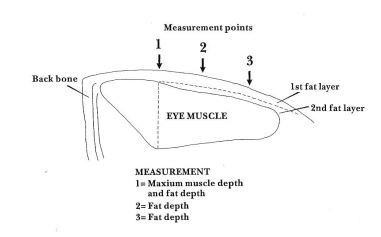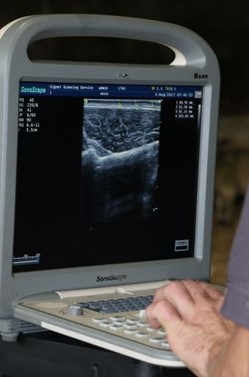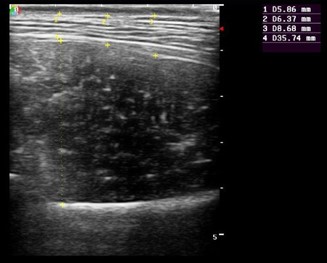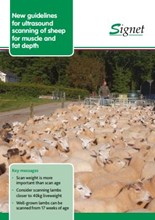Ultrasound Scanning
Scanning to assess Muscle and Fat Depth
A key element of performance recording of sheep through the Signet Sheepbreeder Service is the collection of accurate measurements of muscle and fat using ultrasound scanning machines.
This technical note explains the procedure used to collect muscle and fat data using an ultrasound scanning machine to the standard required when using the Sheepbreeder Service.
Scanning Ages
Well-grown lambs can be scanned from approximately 17 weeks of age, providing there is a relatively narrow spread in lambing dates, to avoid scanning large numbers of very young lambs. We recommend hill breeds
continue to scan at 21 weeks of age.
The most important factor when scanning lambs is to ensure that there is sufficient variation in the muscle and fat depth measurements. This usually requires animals to average at least 35kg with the lightest weighing more than 30kg. Ideally lambs should have some level of finish with over 2mm fat cover. In situations where lambs are growing more slowly it is perfectly acceptable to scan them at an older age to ensure that sufficient levels of variation can be detected.
A weight on the scanning day must also be recorded. Ideally, lambs should have been managed as one group to ensure the largest contemporary comparison groups. Where management has been different, group numbers must be allocated to the animals to record which lambs are managed in the same way.
 Scanning Procedure
Scanning Procedure
The animal needs to be restrained, ideally in a neck restrainer allowing the animal to stand naturally. A trimming stand that holds the head/chin up is not suitable, nor is someone restraining the animal by holding its head and tail.
The animal must stand upright with all four legs on the ground and care must be taken not to have pressure on the sides or back areas in such a way that may distort the muscle area. The use of “conveyor” type races that lift the animal off the ground are suitable as long as the side belts do not exert pressure on the muscle area to be scanned.
The scanning technique involves parting the wool at the third lumbar vertebra at 90 degrees to the backbone and then applying liquid paraffin oil to give contact. The third lumbar is relatively easy to find by counting three
transverse processes back from the last rib, noting that the first spinal process is often very close to the last rib.
The transducer is placed on the prepared site and adjusted until a clear image of the third lumbar transverse process, the eye muscle, and the fat layers can be seen on the machine’s screen.
It is very important to identify all the fat layers and have a clear muscle depth. The picture is then frozen and linear measurements of muscle and fat depths taken on the screen using a cursor.
A single measurement is taken of muscle depth at the deepest point and three measures of fat depth are taken at 1cm intervals. The first fat depth measurement is taken above the muscle deepest point and the following two measurements taken at 1 cm intervals from this point further from the backbone.
Measurements are taken in millimeters to one decimal point. A typical range of fat depths would be between 0.5 – 8mm. Eye muscle depths would typically fall within the range 20 to 36mm, with a few of the biggest terminal sires on intensive diets achieving measurements up to 40mm.
Electronic Transfer of Data
The accurate and efficient delivery of Sheepbreeder performance recording relies on the scanning data being
electronically captured and subsequently emailed to the Signet central bureau for processing onto the Signet
database for analysis. This is achieved by the means of a custom designed programme that can be run on a laptop.
Training and accuracy of scanning technicians
All scanning technicians providing scanning information for Signet Sheepbreeder recording are trained by Signet staff and are required to pass AHDB tests for accuracy and repeatability through the scanning of live lambs.
 Recommendations for clients
Recommendations for clients
Ultrasound scanning of fat and muscle depth is a valuable tool used in Sheepbreeder flocks to help predict carcase fat, carcase lean and muscle. It is carried out usually when the lambs are 17-21 weeks of age. In order to ensure that the most efficient use is made of the technician time available on
farm, please take note of the following points.
- All lambs should be presented for scanning as the analysis involves comparisons with contemporaries. Only late born or very slow growing animals should be excluded. Where lambs of both sexes are to be scanned on the same day it is helpful if they are presented in separate lots.
- Lambs are weighed on the same day as they are scanned so a weigh crate is required.
- The handling must take place undercover, preferably in a building without direct sunlight so the scans can be easily seen and to comply with electrical safety regulations.
- Mains power is necessary at the scanning point. Generators can only be used if fitted with a Voltage Regulator and surge protector.
- A large table (or six small bales) is required for the scanning equipment and must be protected from sheep by hurdles.
- Handling facilities must be adequate and lambs efficiently presented at the scanning point. Ensure adequate help is available to handle lambs safely.
- A head restraining yoke is provided by the scanning technician.
- There is no need to shear the lambs but it is necessary to apply liquid paraffin to the scanning site. (If lambs are to be sheared, the scanning should be done first).
- A minimum of paraffin is used but the amount needed is affected by temperature, wool absorption, and site conditions. Subsequent marks may be seen on animals if the site attracts soil particles or resists bloom
dips used. - Please have your Signet records and/or lambing book to hand in case there are any queries when processing the scanning data.
Service update
Signet recently updated our guidelines for ultrasound scanning.
Further information is available here

